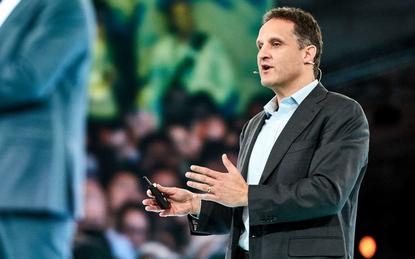How Tableau is fitting into the Salesforce family
- 21 November, 2019 21:22

Adam Selipsk (Tableau)
Customers of the analytics vendor Tableau who arrived at the Dreamforce conference this week wanting to learn about how life may change as a result of its acquisition by Salesforce in a $15.7 billion all-stock deal in May will probably be leaving disappointed.
Salesforce chairman and co-CEO Marc Benioff kicked off the week by welcoming the Tableau CEO Adam Selipsky to the Ohana – the Hawaiian word for welcome which Salesforce uses to refer to its company community – on stage during his keynote on Tuesday.
It was there that Benioff referred to the software as "an amazing product, incredible business intelligence, incredible analytics, incredible visualisation."
Selipsky called it a "natural combination" to join Salesforce, before proceeding to give a basic introduction to the Tableau proposition, without going into any detail regarding product roadmaps and opportunities for deeper integration into the Salesforce stack.
With Tableau executives not doing any press during the conference this week – potentially a hangover from the Competition and Markets Authority (CMA) only approving the merger earlier this month – it was tricky to get these lingering questions answered.
However, earlier this year Selipsky sat down with Computerworld in London to talk broadly about the customer growth opportunities he sees in joining Salesforce, specifically how they "could make Tableau a more easily accessible or even native experience for doing analysis to users of these different Salesforce products."
Where they fit and where they overlap
In terms of how that fits together, Selipsky and Benioff each gave their high-level overviews, which both involved Mulesoft, the integration specialist Salesforce acquired in May 2017 and which was given top billing at Dreamforce last year.
"I think that if you look at all the Salesforce CRM applications that they've built, that are so successful, then you look at the Mulesoft acquisition, which is all about app-to-app integration, then you take Tableau as the next piece in that puzzle, I think all of those assets give the combined company the potential to really provide customers with a single, unified view of all data in their organisations," Selipsky said earlier this year.
"As we've integrated Mulesoft we realised we need to enhance our analytics," Benioff said. "Of course we have done a phenomenal job with Einstein Analytics and artificial intelligence-based analytics, and we have extended that with Marketing Analytics, but the most exciting thing happened this year when we acquired Tableau."
What Benioff is touching upon here is just how much Tableau overlaps with Salesforce's own analytics products.
It seems that both companies recognise that embedded CRM analytics has been solved by Salesforce, and although Tableau could bring a visualisation boost here, the priority is for Tableau to hit any other analytics use cases that Salesforce customers may have.
The two companies also have some client overlap, including J.P. Morgan Chase, Charles Schwab, Verizon, Southwest Airlines and automaker BMW.
"Our concern is not will they bind them closely but will they stay neutral and independent," Rene Wies, vice president of IT systems marketing, sales and aftersale at BMW told Computerworld this week during Dreamforce. "So on the one side, we are happy that things may not have changed significantly because we're still getting the same product."
Dreamforce presence
Selipsky also spoke about how Dreamforce could be used as a "megaphone" for the Tableau brand when we met earlier this year. While the vendor did host a party this week, with fellow Seattle-native Macklemore performing, that didn't really come across on the ground.
In the session catalogue, there were just 36 sessions regarding Tableau, mostly as introductions. Similarly, the Tableau keynote on Wednesday wouldn't have taught any existing customers anything new about the software.
In conclusion, an understanding of where Tableau really fits into the Salesforce stack remains pretty muddy. Of course, this could be good news for customers of the tool who don't want to see it tampered with too much.
As Selipsky put it earlier this year: "Tableau is going to continue to operate independently, inside of Salesforce under the Tableau brand. I think it's important to a lot of our customers to know that the Tableau that they know and love, and the focus we have on the community and our users, is not going away."
